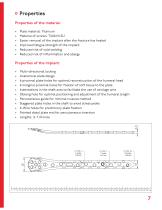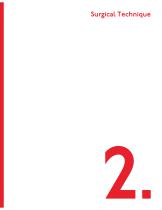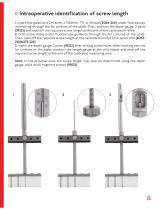
Catalog excerpts

Implants trauma Proximal Humeral Locking Plate
Open the catalog to page 1
CAUTION: Federal Law (USA) restricts this device to sale by or on the order of a board certified physician. WARNING: If there is no sufficient bone healing, wrong or incomplete postoperative care, plate might break. All ITS plates are preformed anatomically as a matter of principle. If adjustment of the plate to the shape of the bone is required, this is possible by carefully bending gently in one direction once. Particular care is required when bending in the region of a plate hole, as deformation of the plate may lead to a failure of the locking mechanism. The plate must not be buckled or...
Open the catalog to page 2
1. Introduction P. 5 Preface P. 6 Screws P. 7 Properties P. 8 Indications & Contraindications P. 8 Time of operation 2. Surgical Technique P. 10 Assembling of the percutaneous guide P. 10 Pre-operative patient preparation P. 11 Exposure P. 11 Reduction P. 12 Plate insertion P. 13 Intraoperative identification of screw length P. 14 Placement of the screws P. 18 Disassembling of the percutaneous guide P. 19 Optional fixation of soft tissue P. 19 Optional fixation in the shaft area with cerclage P. 19 Postoperative treatment P. 19 Explantation 3. Information P. 21 Locking P. 21 Dotize® P. 22...
Open the catalog to page 3
Preface The newly developed Proximal Humeral Locking Plate enables the medical treatment of fractures in the joint area with an optional less invasive method. The special feature of this implant is the free choice of screw placement. The user is able to set any desired screw in any hole (except oblong hole). Especially with complex fractures the free choice of screw angle (+/- 15°, see page 21) has advantages in the fracture treatment.
Open the catalog to page 5
Cortical Screw, locking, D=3.5mm, SH Spiral Drill, D=2.7mm, L=220mm, AO Connector Spiral Drill, D=2.7mm, L=220mm, AO Connector Cancellous Screw, locking, D=4.2mm, SH Spiral Drill, D=2.5mm, L=220mm, AO Connector Guide Wire, Steel, D=1.6mm, L=260mm, TR, w. thread
Open the catalog to page 6
Properties Properties of the material: • • • • • • Plate material: Titanium Material of screws: TiAl6V4 ELI Easier removal of the implant after the fracture has healed Improved fatigue strength of the implant Reduced risk of cold welding Reduced risk of inflammation and allergy Properties of the implant: Multi-directional locking Anatomical plate design 6 proximal plate holes for optimal reconstruction of the humeral head 6 marginal proximal holes for fixation of soft tissue to the plate Indentations in the shaft area to facilitate the use of cerclage wire Oblong hole for optimal...
Open the catalog to page 7
Indications, Contraindications & Time of operation Indications: • All stable and unstable fractures with or without shaft involvement Severe osteoporosis Existing infections in the area of the fracture In cases of skin and soft tissue problems Obesity Lack of patient compliance Time of operation: • Primary as well as secondary after swelling subsides and after temporary fixation
Open the catalog to page 8
Surgical Technique
Open the catalog to page 9
Assembling of the percutaneous guide 1 Pre-operative patient preparation • Positioning on a radiolucent surgical table • Semi-sitting angle of about 30° - 40°, shoulder should be freely moveable (optional shoulder table) • The arm should be freely moveable to allow fracture reduction • General anaesthesia, regional anaesthesia or combination can be used
Open the catalog to page 10
Exposure Anterolateral access: • Skin incision parallel to the anterior acromion and extension 5cm distally in fiber direction of the M. deltoideus. • Detachment of the pars acromialis of the M. deltoideus. Reduction Anatomical reduction of the fracture under fluoroscopy.
Open the catalog to page 11
Plate insertion • • • • Insert the plate, assembled on the percutaneous guide (recommended in Z position) Plate remains in constant contact with the bone and slide distally Align the proximal end of the plate on the Tuberculum majus Verify the correct plate position. Optional temporary fixation with guide wires, steel, D=1.6mm, L=260mm, TR, w. thread (35164-260) into proximal guide wire holes.
Open the catalog to page 12
Intraoperative identification of screw length 1. Insert the guide wire D=1.6mm, L=260mm, TR, w. thread (35164-260) under fluoroscopy monitoring through the far cortices of the plate. Then, position the depth gauge, 2 parts (59222) and read off the required screw length at the end of the calibrated K-Wire. 2. Drill screw holes under fluoroscopy guidance through the far cortices of the plate. Then, read off the required screw length at the calibrated D=2.5/2.7mm spiral drill (61253220/61273-220). 3. Insert the depth gauge, 2 parts (59222) after drilling screw holes. After hooking into the far...
Open the catalog to page 13
Placement of the screws Fix the plate temporarily to the bone and drill with the spiral drill, D=2.7mm, L=220mm, AO Connector (61273-220) in the oblong hole. Drilling is performed through the D=2.8mm drill sleeve (118005-10) that was placed in the tissue protection sleeve (118005-8). Then, the drill sleeve is removed and a D=3.5mm cortical screw (32351-XX) (appropriate length measured before) is inserted through the tissue protection sleeve. Advice: For optimal positioning and adjustment of the humeral length, we recommend to first fill the oblong hole. Therefore there is a centric and...
Open the catalog to page 14
Unscrew the clamping nut (118005-4) up to the black mark (see picture below), rotate the handle 180° and tighten the clamping nut by hand. Then using the spiral drill, D=2.5/2.7mm, L=220mm, AO Connector (61253-220/61273-220) to drill through the drill guide, D=2.7/2.0mm (62202) into a proximal hole. Use the screwdriver, WS 2.5 (56252-150) to insert a D=3.5mm locking cortical screw (37351XX-N) or a D=4.2mm locking cancellous screw (37422-XX-N) of appropriate length determined previously with the depth gauge, solid small fragment screws (59022).
Open the catalog to page 15
Following unscrew the clamping nut (118005-4) up to the black mark (see picture below), rotate the handle 180° and tighten the clamping nut by hand. Then the shaft holes are occupied, optionally with locking or non-locking screws. Use the screwdriver, WS 2.5 (56252-150) to insert D=4.2mm locking cancellous screws (37422XX-N) or D=3.5mm cortical screws, optionally locking or non-locking (32351-XX/37351XX-N) of appropriate lengths determined previously.
Open the catalog to page 16All I.T.S. catalogs and technical brochures
-
ufs
1 Pages
-
DHL
2 Pages
-
ITS
2 Pages
-
PHL
24 Pages
-
ACLS
20 Pages
-
CFN
32 Pages
-
OLS
24 Pages
-
PHLs
20 Pages
-
CTN - Cannulated Tibia Nail
28 Pages
-
SR Sacral Rods
20 Pages
-
HCS
24 Pages
-
TOS Twist-Off Screw
20 Pages
-
TLS
20 Pages
-
PRS-RX
32 Pages
-
HLS
20 Pages
-
ES
20 Pages
-
SR
20 Pages
-
FL
24 Pages
-
PL - Pilon Locking Plate small
12 Pages
-
OL - Olecranon Locking Plate
24 Pages
-
CAS
40 Pages
-
FCN
20 Pages
-
HOL
24 Pages
-
FLS
24 Pages
-
PFL
20 Pages
-
DTL
24 Pages
-
HTO
24 Pages
-
PTL
32 Pages
-
DFL
32 Pages
-
SCL
32 Pages
-
SLS
24 Pages
-
CAL
20 Pages
-
DUL
24 Pages
-
CLS
28 Pages



























































